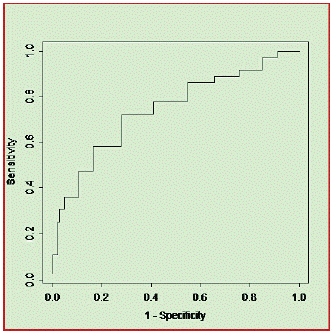To the Editor
Numerous studies have been carried out on determination of glycated haemoglobin to diagnose type 2 diabetes (T2D), among them the manuscript by Selvin et al [1]. They have led the American Diabetes Association (ADA) to recommend haemoglobin A1c (HbA1c) measurements to identify patients having diabetes in their 2010 position statement with a cut off of =6.5 % [2]. Nevertheless, there is some controversial discussion whether HbA1c should be the gold standard for diagnosis of T2D instead of fasting glucose or oral glucose tolerance testing with various arguments in favour of HbA1c [3].
We would like to report our experience with HbA1c, measured in primary care offices in a middle European population under “daily life” conditions. As in many western countries also in Austria T2D is the most frequent cause of end stage renal disease [4], accounting for a high burden to patients and reimbursement systems. Early detection of T2D, subsequently treated adequately is warranted to withhold complications. However, performance of the Oral Glucose Tolerance Test (OGTT) as the diagnostic tool is truly a challenge within the setting of a general practitioners office. Thus, we also wanted to elucidate whether studies like ours are feasible in general practioners offices under daily life conditions.
We studied HbA1c in 8 family medicine offices. During 8 months 3724 persons were screened. History or medical records revealed known T2D in 19.73% and Impaired Glucose Tolerance (IGT) in 15.81%. Due to corticosteroid treatment 3.20% and because of active infection 7.16% were excluded. The inclusion criterion of age =40 years was fulfilled in 2805 of the screened. Finally, 573 agreed to participate in the study and filled in a questionnaire. Among these 231 were selected randomly to have fasting blood tests including HbA1c and an Oral Glucose Tolerance Test (OGTT) for comparison.
OGTT revealed 10 patients with newly diagnosed T2D (blood glucose at 2h =200 mg/dl). In these patients mean HbA1c was 5.77±0.64 %, differing significantly (p=0.0001) from subjects with normal OGTT (HbA1c: 5.07±0.37 %). In 26 patients with IGT (blood glucose at 2h>140 and <200mg/dl) HbA1c was 5.49±0.54 %. ROC-analyses using HbA1c=5.2% revealed a sensitivity and a specificity of 0.72 each (aROC=0.77, see Figure 1). Patients with HbA1c >6.5 % all had T2D according to OGTT (sensitivity 100%). HbA1c-values <4.7% excluded T2D at a specificity of 100%. In univariate logistic regression analysis age, body mass index, systolic blood pressure, total cholesterol and proteinuria significantly influenced No-T2D versus IGT + T2D (p<0.05 each). Included in a stepwise multivariate model, higher age and BMI significantly influenced No-T2D versus IGT + T2D.

Figure 1: ROC-analysis of HbA1c = 5.2% in subjects without DM2 versus patients with DM2 or IGT reveal a sensitivity and specificity of 0.72 each (aROC = 0.77).
The findings within our primary care patient cohort underline HbA1c to be useful for identification of T2D in this setting, which is a proof of concept shown by various authors and recommended by ADA [2]. Its mayor advantage is the single blood drawing independent of day time, acute perturbations like stress, exercise, smoking and fasting state. Therefore, it is easily to manage in primary care offices.
The relatively low incidence of newly diagnosed T2D in our cohort (4.35%) may be explained by the fact that the study physicians all participate in T2D disease management programs with a relatively high prevalence of 19.73% of known T2D and another 15.81% of known IGT. In our study the pre-test probability to detect IGT or DM2 increased with increasing age, BMI, total cholesterol, systolic hypertension, and proteinuria. In conclusion, study physicians as well as patients declared to prefer HbA1c testing instead of OGTT due to feasibility within the setting of a primary care office and within a single office visit.
Author Statements
Acknowledgements
The authors wish to acknowledge the kind cooperation of the members of the Diabetes Study Group and their office teams (in alphabetical order): F Burghuber, Rohrbach, G Gruber, Vorchdorf, N Haberbusch, Wels, Ch Haider, Rohrbach, W Hockl, Enns, B Panhofer, Ungenach, J Pesendorfer, Neukirchen, E Rebhandl, Haslach, C Rocchetti, Linz, G Witzmann, Neumarkt, all in Austria.
Contributions
FCP: Conception and design of study, data processing, interpretation of data, draft and revision of article; SZ: all statistical analyses; ER: conception of study, managing study group, revising article for important intellectual content. All authors have approved final version of article. There are no conflicts of interest to declare with regard to this manuscript.
References
- Selvin E, Steffes MW, Zhu H, Matsushita K, Wagenknecht L, et al. Glycated hemoglobin, diabetes, and cardiovascular risk in nondiabetic adults. New England Journal of Medicine. 2010; 362: 800-811.
- American Diabetes Association. Diagnosis and classification of diabetes mellitus. Diabetes Care; 2010; 33: S62-S69.
- Bonora E, Tuomilehto J. The pros and cons of diagnosing diabetes with A1c. Diabetes Care; 2011; 34: S186-S190.
- Prischl FC, Auinger M, Säemann M, Mayer G, Rosenkranz AR, et al. Diabetes-related end stage renal disease in Austria 1965-2013. Nephrology Dialysis Transplantation. 2015; 30: 1920-1927.
